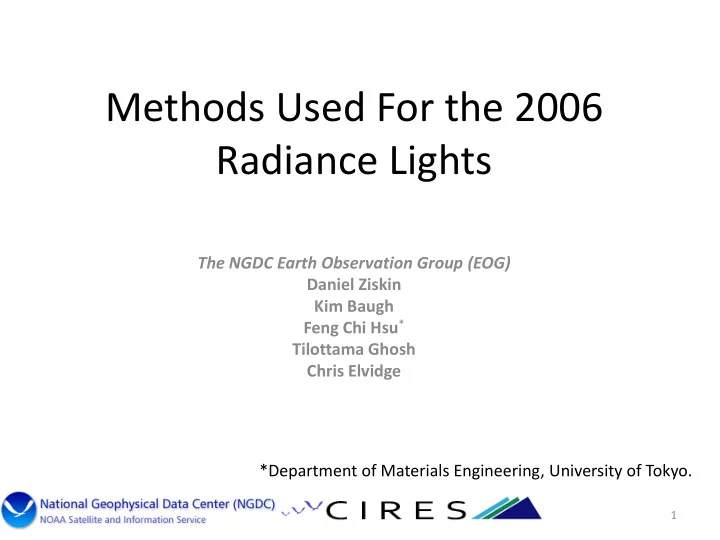

Methods Used For the 2006 Radiance Lights The NGDC Earth Observation Group (EOG) Daniel Ziskin Kim Baugh Feng Chi Hsu * Tilottama Ghosh Chris Elvidge *Department of Materials Engineering, University of Tokyo. 1
The Observations • The Defense Meteorological Satellite Program (DMSP) has flown a long series of satellites. • These satellites have an instrument called the Operational Linescan System (OLS), which was designed as a cloud imager. • Anthropogenic lighting is also detectable at night. • The global data is the result of 5 by 5 pixel averaging (smoothing) onboard. • Digital OLS data have been archived at the National Geophysical Data Center (NGDC) from 1992. 2
The Sensor Normally Saturates Over Bright Urban Areas • The sensor is operated for the purpose of cloud detection. • Six ‐ bit quantization (0 ‐ 63) and limited dynamic range result in saturation over bright urban cores. The Lights Ho Chi Minh City Saturate the Sensor 70 60 50 AVG VIS 40 30 20 10 0 106.55 106.67 106.80 Longitude at 10.8N 3
Pre ‐ Flight Calibration • The saturation is a function of Gain. • The function is read from a pre ‐ launch test chart. • The multipliers are our way of normalizing DN values for intercomparison. 4
Variable Gain • Gain is adjusted continuously both along the satellite track and along the scan line. • The goal is to create “near constant contrast” images for visual interpretation of cloud cover. • Gains are not recorded in the data stream. • Gain is increased as the moonlight decreases and stays low during the period of no moonlight. • Gain is decreased as the moonlight returns. 5
2006 Fixed Gain Observations • Clouds cannot be detected in the visible band nighttime data when there is no moonlight. • On these nights AFWA is amenable to having the gain manipulated. • During 2006 data were collected at low, medium and high gain settings (15, 35, and 55 dB) on 24 hour increments. • Gain 15 ‐ unsaturated observation of bright urban cores. • Gain 35 – saturation possible in urban cores with detection of urban edges and smaller towns. • Gain 55 ‐ detection of dim lighting from small towns and rural areas. 6
Fixed Gain Data Along a Transect Crossing HCMC, Vietnam Fixed Gain 15, 35, 55 of Ho Chi Minh City 900 800 Gain 15 700 600 AVG VIS 500 Gain 35 400 300 FIXED GAIN MULTIPLIER 200 Gain 55 100 15 100 0 35 10 106.55 106.67 106.80 55 1 Longitude at 10.8N 7
Merging Fixed Gain Data • Weighted Mean – Number of observations – Proximity to saturation • Smooth data may include saturated pixels Stable Lights and Fixed Gain 15, 35 of Ho Chi Minh City 900 800 700 AVG VIS 15 600 AVG VIS AVG VIS 35 500 400 CALC MERGE 300 200 100 0 106.55 106.67 106.80 Longitude at 10.8N 8
Blending with Stable Lights Product Sao Paulo, Brazil F16 2006 • Fixed Gain products tend to have three flaws: – Low numbers of coverage in some places. – Anomalous events, such as fires, are included. – Noise. • Blending with Stable Lights processed from operational data improves each of these issues. RED – FG MERGED – Fires. GREEN – Stable Lights. 9
The Blending of the Fixed Gain and Stable Lights is Based on Linear Regression of Gain 55 and Stable Lights in the Nile Delta 10
Comparison of the Stable Lights and Radiance Lights Stable Lights of Ho Chi Minh City Radiance Calibrated Lights of Ho Chi Minh City RED = 60 ‐ 63 DN Central Core ~ 800 DN 11
Ongoing Effort on Radiance Lights • Low, medium and high fixed gain data were collected in 1996 ‐ 97, 1999, 2000, 2003, 2006 and an ongoing collection is being made in 2010. • NGDC is attempting to process a consistent series of radiance products. • Major issue to be resolved is how to intercalibrate the products from the various years. 12
Download the Data You can download the 2006 radiance product from: www.ngdc.noaa.gov/dmsp/download_radcal.html 13
Recommend
More recommend